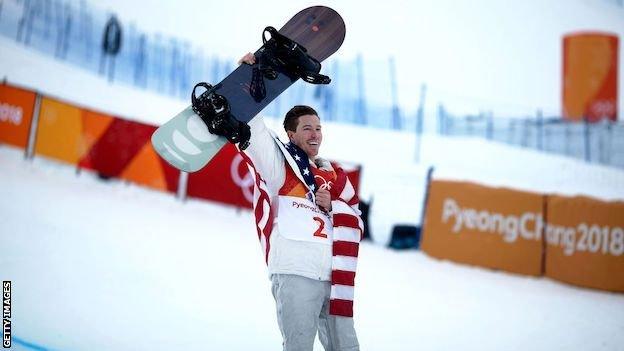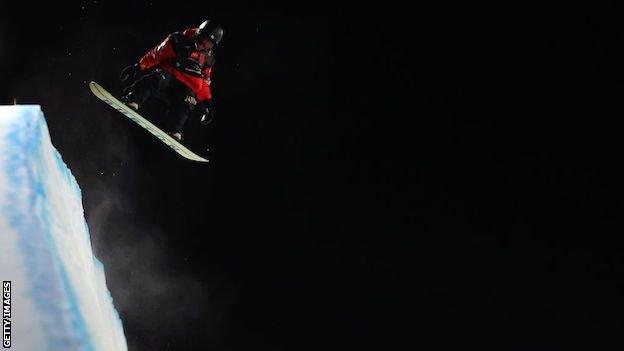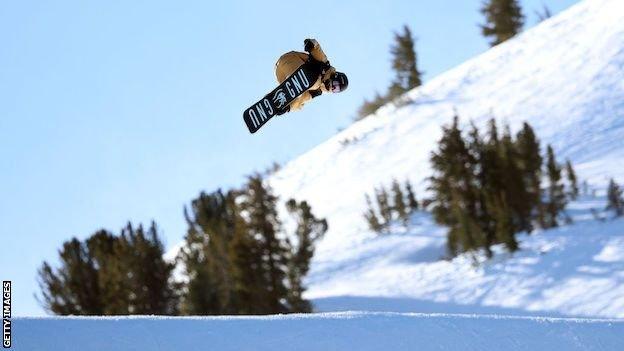Winter Olympics: Why Beijing 2022 promises the most progressive snowboarding ever seen
- Published

Shaun White has won three Olympic halfpipe titles - can he win a fourth at the age of 35?
One thing is certain in my mind - this will be the most hotly contested Olympic Games yet for snowboarding - and promises some of the most progressive action ever seen.
That's a huge claim, especially considering the battle that took place for the men's halfpipe medals four years ago in Pyeongchang.
Many people thought that epic contest, which saw Japan's Ayumu Hirano, Australia's Scotty James and American Shaun White pushed way beyond their comfort zones, would never be bettered.
How wrong they were. If anything, in 2022 the stakes are even higher.
'The greatest showdown'
So let's start with the men's halfpipe. Instead of just three names battling it out for medals this time, we now have six.
White is now 35. In action sports terms that is positively Jurassic and yet he is still capable of making the podium at any contest he enters. With a new coach and more relaxed mindset he looks, for the first time, to be enjoying his snowboarding.
It's no longer a win-at-all costs battle in which losing is absolutely unacceptable - but winning will be a huge ask for the three-time Olympic gold medallist.
The Japanese are the superpower of superpipe riding. Three of the six riders in the running for medals hail from the land of the rising sun and they are incredibly good. Hirano was 15 when he won his first Olympic silver medal in 2014 and he had to settle for silver again in Pyeongchang.
He is determined not to settle for silver a third time and to ensure that, he broke the seal on the triple cork in training in October. He then became the first man to land it in competition in December.
This terrifying trick sees the rider spin 1,440 degrees on the horizontal axis whilst corkscrewing the rotation, so the head dips under the board three times.
This is where it gets interesting. Both Hirano's younger brother Kaishu and fellow countryman Yuto Totsuka also have the triple, but whether they will be consistent enough to land it in Beijing is the big question.

Japan's Ayumu Hirano is the first man to land a triple cork in competition
Australia's 16-year-old Valentino Guseli is far from the finished product technically but, in 2021, he bettered White's age-old record of the highest air out of a halfpipe, going 7.3m. If he can add one or two big rotations to his run, he could be the dark horse.
Then there's his fellow Aussie James, who could well end up as snowboarding's ultimate Shakespearean tragedy.
He won nine events in a row between 2018 and 2020, utterly dominating halfpipe competition - and then he saw his run eclipsed by Totsuka.
In the last two years he has cut an increasingly frustrated figure, even paying millions this winter to train on a Swiss glacier in his own private pipe. But in late January, at just his second contest of the winter, he put down the run of his life at the X Games in Colorado and managed to beat Ayumu Hirano and, crucially, his triple…
With the level of talent and the stakes so high, it promises to be without doubt the greatest showdown in men's halfpipe history.
In the women's event, things are far more straightforward.
Chloe Kim hasn't lost a halfpipe contest since March 2019. Her two 1080s - the rest of the field have one at most - and wonderful ability to ride switch (backwards) mean she is still head and shoulders above her rivals. Many pundits joke she won't need to train until after her third gold medal in 2022.
It will be a battle for silver and bronze and that will happen between the Chinese favourite and most successful contest rider of all time Cai Xuetong, the Spanish veteran Queralt Castellet - a creative rider coached by 2002 silver medallist Danny Kass - and young Japanese prodigy Mitsuki Ono.
'Breathtaking progression'
Slopestyle and big air are different disciplines but athletes are bound to compete in both if they qualify.
In the men's, keep an eye on 2018 gold medallist Red Gerard, who has timed his run of form into the Games perfectly, while Finland's Rene Rinnekangas is a gloriously spontaneous talent.
Canada are one of the strongest nations in slope and big air and they have a team of warriors.
Mark McMorris rode through broken ribs in 2014 and took bronze, suffered a broken femur in 2016 and then in 2017 hit a tree and suffered catastrophic injuries.
Seventeen broken bones, a ruptured spleen and a collapsed lung saw him put in a medically-induced coma, but 11 months later he again took bronze in Korea. It would be a fairytale finish to 'McLovin's' competitive career to finish with a gold.
But the 28-year-old will have to get past two other Canadians, cancer survivor and 2018 silver medallist Max Parrot, and Sebastien Toutant, aka Toots.
The biggest variable comes in the shape of Norwegian Marcus Kleveland. He struggles with consistency, but his aerial awareness has been driving the giant leap forward in spin rotations that we've seen during this Olympic cycle. In 2018, 1620s were the zenith of big air rotations, but this year the medals will be decided by 1800s and even 1980s - a breathtaking progression in just four years.

Jamie Anderson has won the last two women's Olympic slopestyle titles
In the women's, there is a fantastic battle shaping up for gold. American Jamie Anderson's career has spanned more than 16 years and she has utterly dominated women's snowboarding, including two Olympic golds in slopestyle and a silver in big air.
Then you have the young New Zealander Zoi Sadowski-Synnott. She won big air bronze in 2018 aged 16, but has methodically perfected her craft in the following four years.
Of the riders battling it out for bronze there is the young Australian Tess Coady, whose riding has matured at a phenomenal rate, Canadian Laurie Blouin - who always shines when conditions deteriorate - and Great Britain's Katie Ormerod. It took seven surgeries to fix a shattered heel sustained on the eve of Pyeongchang, but Ormerod's solid fundamentals have shone through and she claimed the slopestyle World Cup title in 2020.
Anna Gasser often struggles in slopestyle, but she is pushing the outer limits of big spins, in particular the hallowed triple cork. She could push women's riding into the stratosphere in China and claim a second big air gold in the process.
The effect of the Olympics on snowboarding since its introduction in Nagano 1998 has been to turbo charge progression.
Every time you think a ceiling has been reached, a new generation of riders smash through it. That is certainly the case for Beijing 2022, where we can expect a host of riders to push themselves and the sport into new realms.
As a neutral it's a mouth-watering prospect.